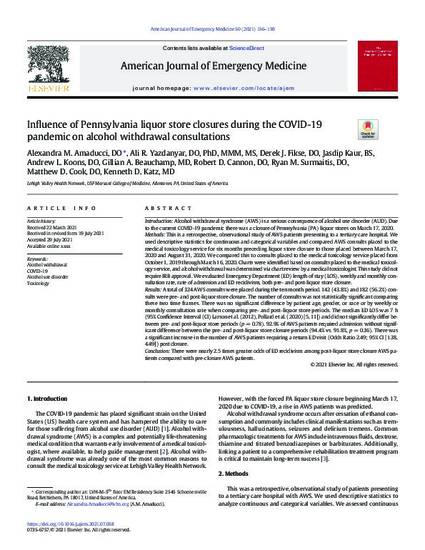
INTRODUCTION: Alcohol withdrawal syndrome (AWS) is a serious consequence of alcohol use disorder (AUD). Due to the current COVID-19 pandemic there was a closure of Pennsylvania (PA) liquor stores on March 17, 2020.
METHODS: This is a retrospective, observational study of AWS patients presenting to a tertiary care hospital. We used descriptive statistics for continuous and categorical variables and compared AWS consults placed to the medical toxicology service for six months preceding liquor store closure to those placed between March 17, 2020 and August 31, 2020. We compared this to consults placed to the medical toxicology service placed from October 1, 2019 through March 16, 2020. Charts were identified based on consults placed to the medical toxicology service, and alcohol withdrawal was determined via chart review by a medical toxicologist. This study did not require IRB approval. We evaluated Emergency Department (ED) length of stay (LOS), weekly and monthly consultation rate, rate of admission and ED recidivism, both pre- and post-liquor store closure.
RESULTS: A total of 324 AWS consults were placed during the ten month period. 142 (43.8%) and 182 (56.2%) consults were pre- and post-liquor store closure. The number of consults was not statistically significant comparing these two time frames. There was no significant difference by patient age, gender, or race or by weekly or monthly consultation rate when comparing pre- and post-liquor store periods. The median ED LOS was 7 h (95% Confidence Interval (CI) Larson et al. (2012), Pollard et al. (2020) [5, 11]) and did not significantly differ between pre- and post-liquor store periods (p = 0.78). 92.9% of AWS patients required admission without significant difference between the pre- and post-liquor store closure periods (94.4% vs. 91.8%, p = 0.36). There was a significant increase in the number of AWS patients requiring a return ED visit (Odds Ratio 2.49; 95% CI [1.38, 4.49]) post closure.
CONCLUSION: There were nearly 2.5 times greater odds of ED recidivism among post-liquor store closure AWS patients compared with pre-closure AWS patients.
Amaducci, A. M., Yazdanyar, A. R., Fikse, D. J., Kaur, J., Koons, A. L., Beauchamp, G. A., Cannon, R. D., Surmaitis, R. M., Cook, M. D., & Katz, K. D. (2021). Influence of Pennsylvania liquor store closures during the COVID-19 pandemic on alcohol withdrawal consultations. The American journal of emergency medicine, 50, 156–159. Advance online publication. https://doi.org/10.1016/j.ajem.2021.07.058
